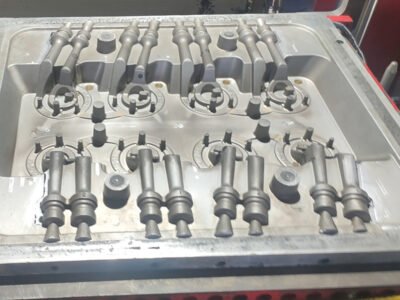china stainless steel investment casting parts

In the realm of metalworking, stainless steel investment casting parts have become an indispensable component in numerous industries. This article aims to provide a detailed and comprehensive guide to the manufacturing process, advantages, and applications of China stainless steel investment casting parts.
1. Manufacturing Process
The investment casting process, also known as the lost wax casting process, involves creating a wax pattern, making a ceramic shell, melting the wax, and then pouring molten metal into the shell. Here is a step-by-step breakdown of the process:
a. Design and Pattern Creation: The first step is to design the part and create a wax pattern. The pattern is usually made using CNC machining or by hand sculpting.
b. Shell Molding: The wax pattern is then dipped into a slurry, which consists of a ceramic slurry and a hardener. After the slurry hardens, the pattern is dipped into sand, which forms a solid shell around the pattern.
c. De-waxing: The shell is then heated to melt the wax, leaving a cavity in the shell that matches the shape of the original wax pattern.
d. Metal Pouring: Molten stainless steel is then poured into the cavity, filling the space where the wax was. Once the metal has solidified, the shell is broken away, revealing the stainless steel investment casting part.
2. Advantages of China Stainless Steel Investment Casting Parts
a. Complex Shapes: Investment casting allows for the creation of complex shapes and intricate details that are difficult to achieve with other casting methods.
b. High Dimensional Accuracy: The precision of investment casting is higher than other casting methods, making it suitable for applications that require tight tolerances.
c. Lightweight: Investment casting can produce lightweight parts with excellent strength, which is beneficial for applications where weight reduction is crucial.
d. High Surface Finish: The investment casting process results in a smooth and high-quality surface finish, which reduces the need for additional finishing operations.
e. Cost-Effective: Despite its high precision, investment casting is a cost-effective method for producing small to medium-sized batches of stainless steel parts.
3. Applications of China Stainless Steel Investment Casting Parts
a. Automotive Industry: Investment casting is widely used in the automotive industry for producing engine components, exhaust systems, and suspension parts.
b. Aerospace Industry: The aerospace industry utilizes investment casting for manufacturing lightweight and high-strength parts, such as turbine blades and engine components.
c. Medical Industry: Investment casting is used in the medical field for producing orthopedic implants, surgical instruments, and dental devices.
d. Energy Industry: Investment casting is employed in the energy sector for manufacturing components of wind turbines, solar panels, and oil and gas equipment.
e. General Engineering: Investment casting is used in various general engineering applications, such as pump components, valves, and industrial machinery.
4. Materials Used in China Stainless Steel Investment Casting Parts
Stainless steel is the most commonly used material in investment casting due to its corrosion resistance, high strength, and excellent mechanical properties. Some of the most popular stainless steel grades used in investment casting include:
a. AISI 316: This grade is known for its excellent corrosion resistance and high strength, making it suitable for applications in harsh environments.
b. AISI 304: AISI 304 stainless steel is widely used for its good formability and weldability, as well as its corrosion resistance.
c. AISI 321: This grade is known for its high-temperature strength and excellent corrosion resistance, making it suitable for applications in high-temperature environments.
5. Challenges and Solutions in China Stainless Steel Investment Casting Parts
a. Porosity: Porosity is a common issue in investment casting, which can affect the mechanical properties of the part. To mitigate this, it is essential to optimize the wax pattern design, ceramic shell, and metal pouring process.
b. Oxide Inclusions: Oxide inclusions can form during the casting process, which can affect the surface finish and mechanical properties of the part. To prevent this, it is crucial to use high-purity metal and optimize the metal pouring process.
c. Dimensional Tolerance: Achieving tight dimensional tolerances in investment casting can be challenging. To ensure accuracy, it is important to use high-quality materials, precise equipment, and skilled operators.
6. Commonly Asked Questions
1. What is the difference between investment casting and other casting methods?
Investment casting allows for the creation of complex shapes and intricate details, higher dimensional accuracy, and lightweight parts compared to other casting methods such as sand casting or die casting.
2. Can investment casting be used for large parts?
Yes, investment casting can be used for large parts; however, it may be more cost-effective for smaller batch sizes due to the higher cost of tooling and setup.
3. What are the advantages of using stainless steel in investment casting?
Stainless steel is preferred in investment casting due to its corrosion resistance, high strength, excellent mechanical properties, and good formability and weldability.
4. How can porosity in investment casting be prevented?
To prevent porosity, it is essential to optimize the wax pattern design, ceramic shell, and metal pouring process, as well as use high-purity metal.
5. What is the typical surface finish of investment casting parts?
The surface finish of investment casting parts is generally smooth and high-quality, which reduces the need for additional finishing operations. The surface finish can vary depending on the application and customer requirements.
